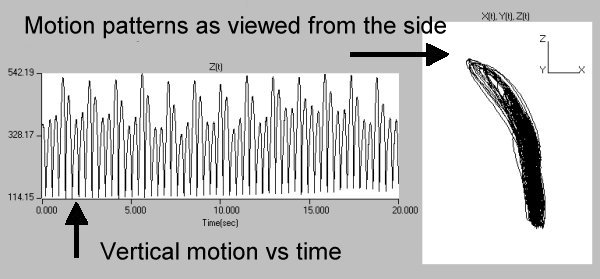Sofia Dahl, sofia@speech.kth.se
Department of Speech, Music and Hearing, Royal Institute of
Technology (KTH), Stockholm, Sweden
Virgil P. Stokes,
Biomechanics and Motor Control, Department of Neuroscience, Karolinska
Institute, Stockholm, Sweden
Popular version of paper 5aMUa5
Presented Session: Friday Morning, March 19, 1999
ASA/EAA/DAGA '99 Meeting, Berlin, Germany
How does a performer execute highly specialised movements? Our admiration for people skilled at playing musical instruments, creating artworks or in other ways managing complicated movements with high accuracy is generally built on the knowledge that the task is difficult. Yet the performance of an experienced artist is almost always fluent and relaxed. Indeed, most of us develop a relaxed and fluent handwriting - a motor skill we perform daily. We even display our own recognisable "trademarks" in doing so. But to acquire an automatic and relaxed performance of this skill the learning period is long, probably several years.
The same goes for when we learn to play an instrument. Guidance by a skilled player in combination with extensive practice is necessary to reach a professional level. There are, however, limits to how detailed the instructions from a teacher can be. Much of the knowledge of how to play an instrument is based on intuitive feelings, which can be hard to pass on to a student.
An experienced drummer will take advantage of the feedback from the instrument. Difficult or fast sequences can be played with much less effort if the rebound of the drumstick can be used. (For example; Think of letting a rubber ball drop to the ground. Because it bounces back, you don't have to pick it up, and so little energy is used). Depending on the circumstances one can, however, assume that there might be a trade-off between close control of the drumstick and very relaxed playing.
The preliminary results reported here evolved from an experiment where movement data and timing patterns for three professional percussionists and one amateur were recorded. To register the movement, markers with LEDs were attached to the player's right arm and to the drumstick. To get a measure of the force in each stroke the subjects played on a force plate, the output of which was recorded simultaneously. The task given to the subjects consisted of single strokes with interleaved accents played at three different tempi and at three dynamic levels. The different tempi were played to the subjects by a metronome that was turned off before the recording. The dynamic levels, pp, mf and ff, were left to the subjects to decide.
To see an example of a recording, use Quick time to view this video-clip:
From this recording the three-dimensional co-ordinates for each of the markers can be studied. The displacement along the x-, y- and z-axis, representing forward-, sideways- and vertical motion respectively, can be viewed versus time as well as the over-all "playing pattern" throughout the whole recording sequence. In the example below, the pattern to the right illustrates the movement of the stick as viewed from the side. The preparation for the accented blows, appearing every fourth stroke, can easily be spotted in the z-graph that illustrates the vertical motion of the stick versus time. The rebound after the accented blow also takes the stick up higher than in the preparation for the other, unaccented strokes.

Fig. 1. This figure shows data from the sequence played in the video-clip
above. The vertical motion of the drumstick is displayed in mm versus time
(left) and the playing pattern during the whole sequence is displayed as
viewed from the side (right).
The playing styles differed widely between subjects. Although given the
same task all subjects performed it differently as shown in the figure below.
Fig. 2. Comparisons between motion patterns for the four subjects
One way to study timing is to analyse the separation of the strokes in
time, the inter-onset intervals (IOIs). As the name implies the time
between the onset of each stroke in the signal is measured. In the figure
below these IOIs are plotted for each interval. An arrow indicates the
nominal tempo (200 beats per minute).
Fig. 3. Inter-onset intervals (IOIs) for the three sequences played at 200
beats per minute (BPM). The three dynamic levels are indicated by squares
(pp), stars (mf) and triangles (ff).
An interesting finding was that in most cases the subjects did not
duplicate the tempo given to them prior to the recording. In other words
the subjects often started to play at a rate that was either faster or
slower than the given tempo; in some cases by as much as 50 ms. This was in
spite of the fact that the metronome was turned off at the player's own
request less than 5 seconds before the playing started.
These preliminary results will be reported at the Acoustical Society of
America 132nd Meeting in Berlin 1999. This research is part of an ongoing
investigation supported by the Bank of Sweden Tercentenary Foundation.

